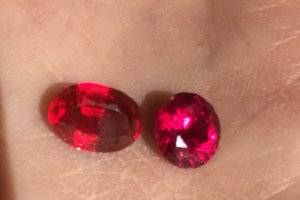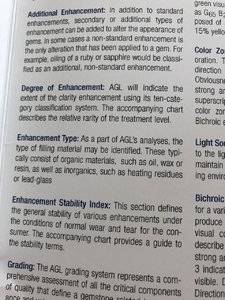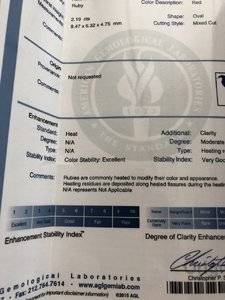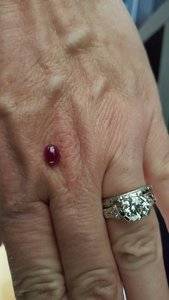- Joined
- Mar 2, 2013
- Messages
- 6,307
I knowingly purchased a ruby from a PS vendor that - per the accompanying AGL brief - is noted to have been heated and contain clarity residues.  Why? Because 1) I like the color; 2) it wasn’t an ‘investment’ purchase nor ‘expensive’ or overpriced IMO; and 3) there is a return period if it’s not all I hope for it to be. I’ll also further note, there was no attempt at hiding the treatment by the vendor; it was a very transparent discussion and sale. Just laying all of that out up front so the conversation doesn’t cause undue worry that I was misled, that the vendor was sketchy, etc.
Why? Because 1) I like the color; 2) it wasn’t an ‘investment’ purchase nor ‘expensive’ or overpriced IMO; and 3) there is a return period if it’s not all I hope for it to be. I’ll also further note, there was no attempt at hiding the treatment by the vendor; it was a very transparent discussion and sale. Just laying all of that out up front so the conversation doesn’t cause undue worry that I was misled, that the vendor was sketchy, etc.
In the comments section of the AGL brief, it notes:

In my conversation with the vendor about this particular ruby before purchasing, it was noted to likely be from the Mong Hsu/Burma region, and that he talked with AGL awhile back (presumably when it was cert’d) specifically about the treatment, and they noted that heating with flux healing was quite common when these stones/rough were obtained in the 90s, and the flux used in heating creates the residues that are noted; that it was NOT fracture filled nor glass filled. It was noted to be a very stable treatment in my conversation with the vendor as well as on the AGL brief, and that really was my primary concern. So I bought it to see if the color really is - in person - what I’m looking for.
The treatment interested me as I’ve not really done a ton of reading about it, so I’ve done a lot of reading over the last 24 hours to understand the history on rubies from the Mong Hsu region, the treatment that was occurring there, etc. But I’ll be honest, a LOT of what I read from GIA reports, an article by Richard W. Hughes & Olivier Galibert on Mong Hsu rubies, and even excellent posts from some of our own very knowledgeable PSers while quite informative, were still quite a bit over my head. I’m not a science person, and I feel like I’d need a PhD to fully comprehend all of what I read.
Some of the articles & PS posts - which were mostly several years old - seemed a little contradictory to whether fracture healing and filling were different or one in the same from a perception perspective, so it confuses me.
My question is - aside from individuals’ personal bias/preference for untreated vs. heat only vs. heat plus other treatment:
1) Is the difference between healed vs. filled a matter of perspective/opinion or fact?
2) If the latter, is there a ‘for dummies’ explanation of how they are in fact different or the same?
3) If it’s a matter of perspective for anyone on here, can you share why you feel they are different or the same?
I appreciate any perspective & insight from the group, and hopefully this can be a good dialogue for others who might be considering a similar ruby purchase as it really is hard to piece together the input from so many different articles & threads.
In the comments section of the AGL brief, it notes:

In my conversation with the vendor about this particular ruby before purchasing, it was noted to likely be from the Mong Hsu/Burma region, and that he talked with AGL awhile back (presumably when it was cert’d) specifically about the treatment, and they noted that heating with flux healing was quite common when these stones/rough were obtained in the 90s, and the flux used in heating creates the residues that are noted; that it was NOT fracture filled nor glass filled. It was noted to be a very stable treatment in my conversation with the vendor as well as on the AGL brief, and that really was my primary concern. So I bought it to see if the color really is - in person - what I’m looking for.
The treatment interested me as I’ve not really done a ton of reading about it, so I’ve done a lot of reading over the last 24 hours to understand the history on rubies from the Mong Hsu region, the treatment that was occurring there, etc. But I’ll be honest, a LOT of what I read from GIA reports, an article by Richard W. Hughes & Olivier Galibert on Mong Hsu rubies, and even excellent posts from some of our own very knowledgeable PSers while quite informative, were still quite a bit over my head. I’m not a science person, and I feel like I’d need a PhD to fully comprehend all of what I read.
Some of the articles & PS posts - which were mostly several years old - seemed a little contradictory to whether fracture healing and filling were different or one in the same from a perception perspective, so it confuses me.
My question is - aside from individuals’ personal bias/preference for untreated vs. heat only vs. heat plus other treatment:
1) Is the difference between healed vs. filled a matter of perspective/opinion or fact?
2) If the latter, is there a ‘for dummies’ explanation of how they are in fact different or the same?
3) If it’s a matter of perspective for anyone on here, can you share why you feel they are different or the same?
I appreciate any perspective & insight from the group, and hopefully this can be a good dialogue for others who might be considering a similar ruby purchase as it really is hard to piece together the input from so many different articles & threads.








300x240.png)